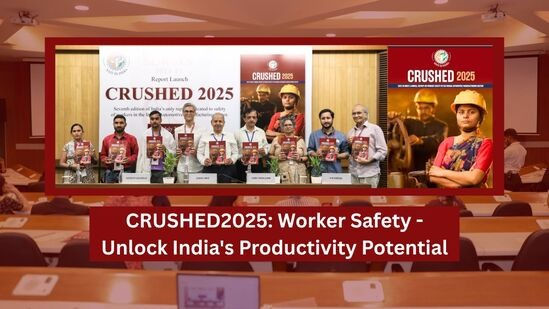CRUSHED2021 worker-injury data not valid? and thank you Journalists!
- Safe in India

- Mar 26, 2022
- 5 min read
Updated: Jul 5, 2024
The issues of the working class, which were once prominently and robustly covered in Indian newspapers (and indeed Bollywood), are now not a priority for most media houses, and even when covered, are relegated to the crowded, hard-to-read sections. Labor beat, that was a significant part of journalism in the past, has had a death by a thousand cuts. How can we provide dignity to crores of workers' lives if we are not made aware of their ground reality? If Supriya Sharma had not written this article on "20 worker lose their hands/fingers every day in Gurgaon", would SII have ever been born?
This blog is therefore to thank those journalists who chose to cover our third annual sequel of
worker accident prevention report- CRUSHED2021. And to request other media houses and journalists especially those in Hindi media (we have failed to engage them), to provide attention to this important issue - not only for its obvious humanitarian need, but also to help Indian manufacturing where India’s labor productivity has further worsened from 115th to 128th in the world.
First, let's address a comment from "a government official" in Haryana about inaccuracy of our worker injury data (only one thankfully - many other government officials continue to accept our findings and recommendations - with varying degree of urgency of actions)

Siddharth Tiwari in this excellent article, where he elicited response from many stakeholders including Maruti, Hero, SIAM and ACMA, in Times of India, quoted a "senior government official" from the Industry Safety and Health (ISH) wing of the Haryana government's labor department: "...but many of the accidents reported by SII are either from the unorganized sector or ones that happened outside the factory and have been wrongly assumed to be factory accidents"
Unfortunately, this is a misleading statement that we would like to clarify it again, as indeed we have done a few times in the past:
1. All these 3,000+ injured workers reported in CRUSHED2021 were/are registered with ESIC (Employee State Insurance Corporation) which by definition makes them organised/formal sector workers and factories.
2. As the below picture in the report clearly states, only 6% of the reported 3,000+ accidents are road accidents and remaining 94% inside the factories. This information is provided by injured workers themselves, while obtaining ESIC treatment/compensation.
Even this small 6% number, we suspect, includes injuries that happened inside factories, but where workers were forced to report them as road accidents.

3. In 2019/20, DG FASLI (central government's factory safety agency) sample-checked our data of CRUSHED2019. After that central labour ministry constituted a working group to address the issue (we are still trying to find out the recommendations of this working group but a few things have moved since in DG FASLI and Haryana).
4. We even shared the data for CRUSHED2021 with ISH, Haryana in late 2020, as they asked us to do, and have received no comments until date.
In fact, all three CRUSHED reports have been accepted for action(s) by many central and Haryana state government departments, and the auto sector brands and their apex organizations.
Hopefully, the above settles this issue (but challenges are always welcome!).
It is no surprise that in the opinion page of the Hindu, Prof. K.R. Shyama Sundar, in this insightful article covering our report, commented on the "lack of labor statistics system and dismal state of factory inspections in auto factories" and called for a robust labor statistics system.

For the TOI article by Himanshi Dhawan, she visited our Manesar operations and spoke to a number of workers herself, highlighting "70% of injured workers lost their hands/fingers":

Sumant Banerjee, now consulting editor at ET Auto, has covered every annual edition of the CRUSHED reports these past three years. He was recently awarded the prestigious Ramnath Goenka award for excellence in journalism in the Business and Economic Journalism category for his story that highlighted our data/report, which Banerjee acknowledged with 'Special thanks also to @safeinindia1 for the work they do"

Ashok Kumar in his article in The Hindu highlighted the finding that "the lower the salary and the educational attainments, the worse is the injury received with 92% of those injured being migrants, 81% educated only up to grade 10 and 71% earning less than ₹10,000 a month with no overtime pay for many despite a 12-hour shift".

Divya Trivedi at the The Frontline outlined the national scope of the problem and highlighted the role of major OEMs in these accidents as “between April 2020 and September 2021, it was found that 93 percent of the injured workers in Gurugram and 75 per cent in Faridabad were employed by suppliers of Maruti Suzuki, Hero MotoCorp and Honda, or a combination of them. The other major OEMs were no bystanders in this issue either as from April to September 2021, 55 per cent of the injured workers were employed with other OEMs such as JCB, Yamaha and Escorts”.

Gaurav Vivek Bhatnagar covering the report for The Wire highlighted the finding that Indian auto factories are plagued with issues of “poor adherence to training and safety norms”, the starkest example being the accidents on "power press machines - the reason for 59% of the injuries in auto factories" and "88% of the accidents (on power press) were found to be occurring because the safety sensors or related mechanisms do not work".

Kavita Charanji, writing for Civil society, spent half a day with our team in Faridabad and covered our worker assistance operations on the ground. She presented a first person account of "affected workers as they struggle to get their compensation from ESIC and (SII's) assistance to help them get through the bureaucratic jungle and red tape to get their rightful benefits".


Professor Shyam Sundar also presented an incisive analysis of legal aspects of industrial safety in Indian auto factories in the Leaflet, a respected legal news organization, in the context of new labor codes and SDGs regulations discussed in the report.
Basant Kumar Mohanty, writing for the Kolkata edition of The Telegraph gave special attention to "the pervasive lack of safety culture and contravention of legal provisions meant for wider safety".
We must also add our appreciation to other journalists who have covered our previous reports: CRUSHED2019, CRUSHED20, SafetyNiti 2021 and ESIC surveys "ESIC ki Baat, Aapkay Saath"
Swaraj Baggonkar of Money Control, Nehal Chaliawala of The Economic Times, Nidhi Sharma of The Economic Times, Shubhra Pant of The Times of India, Abhishek Bhel of The Hindustan Times, Rhythma Kaul of The Hindustan Times, Yogima Seth Sharma of The Economic Times, Shreeja Singh of Money Control, Rajini Vaidyanathan of BBC News, Ramapriya Gopalakrishanan of LiveLaw, Deepak Upadhay, Mint, and Saranya Chakraprani, Times of India, and many more to whom we apologize for not covering them here.
We gratefully acknowledge the contribution of all these journalists! Thank you and look forward to your continued support to make the public, the auto sector, the workers and the government aware of these issues and their potential solutions.
Stay safe!
team@safeinindia.org







































Comments